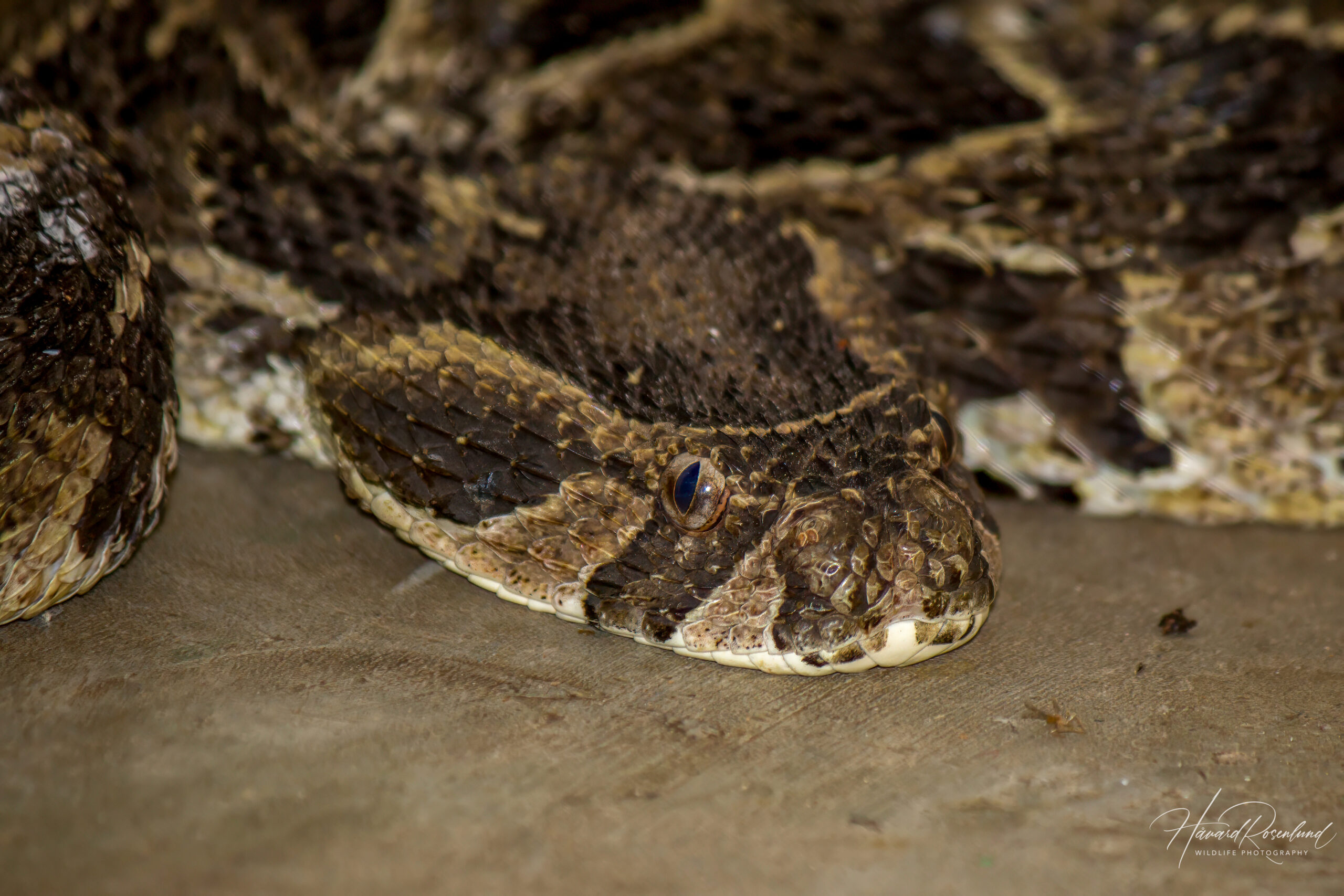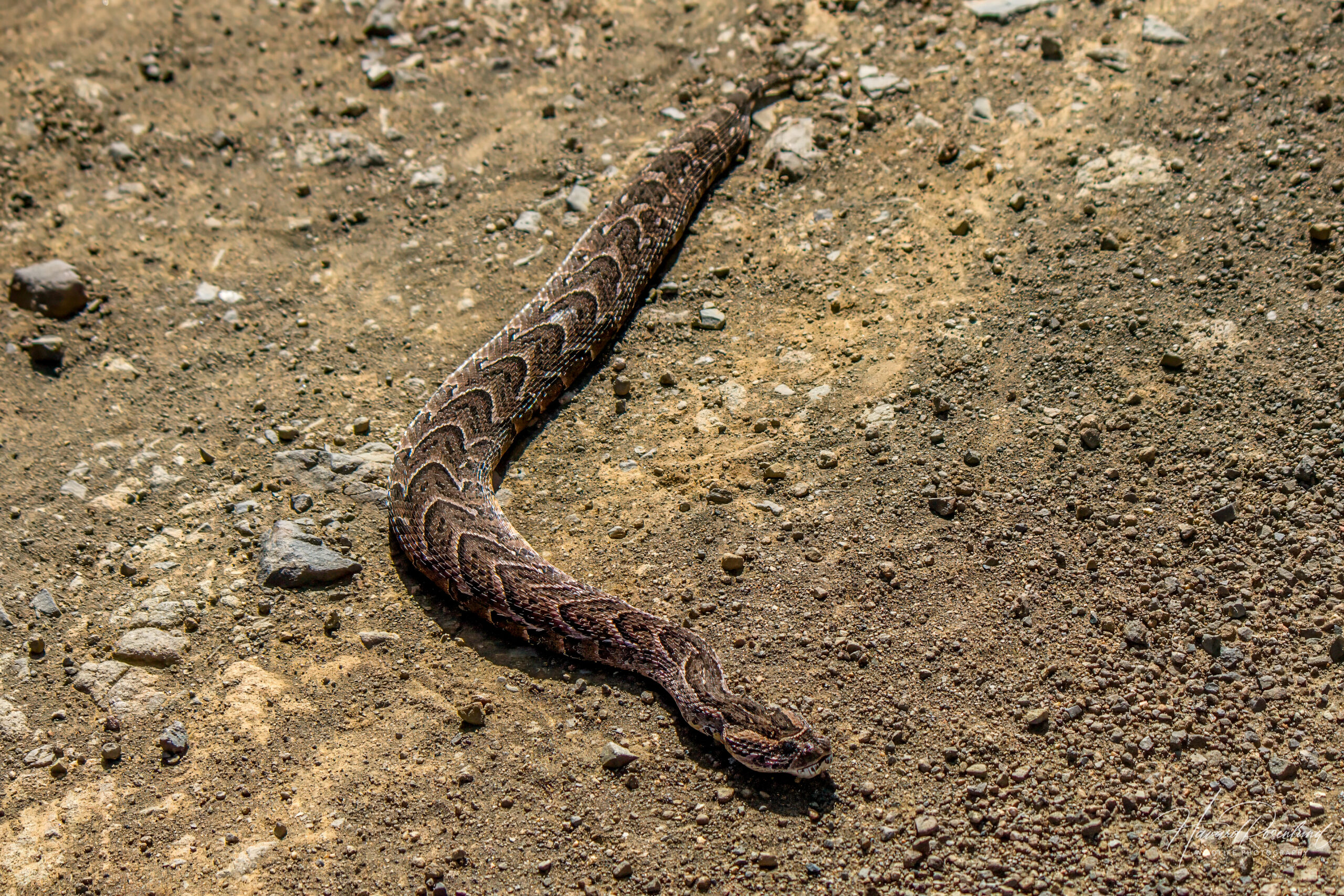Description
The puff adder (Bitis arietans) is a common and highly venomous species of viper in Africa and parts of the Arabian Peninsula. This is a heavy and stout snake, with an average length of 1 m (3 ft 3 in). Specimens up to 1.9 m (6 ft 3 in), weighing over 6 kg (13 lb) and with a width of 40 cm (1 ft 4 in) have been recorded, making it the largest species of viper in Africa. Specimens on the Arabian Peninsula are typically smaller.
Color varies greatly, especially between geographical regions and populations. It is often brown or light brown, but can also be light yellow, bright yellow, yellowish brown, orange-brown and grey. Almost all specimens have the same V-shaped or U-shaped dark-light banded pattern on the back. It also has two lighter bands on the sides on top of its head stretching backwards from each eye. Like most vipers, it has a triangular-shaped head.
Diet & habitat
The puff adder is common in a large range of habitats, but is not found in true deserts, alpine environments, dense tropical forests, and rain forests. It often prefers open rocky grasslands and scrub habitats. It is mostly active at the night. It is an ambush predator, relying on its camouflage and stealth when looking for food. It usually lays still and motionless, sometimes for hours, while waiting for adequate prey to come by. When prey is close enough, the puff adder will strike fast and inflict venom into its victim before eating it whole. Sometimes it will let the prey get away after striking it and then follow the prey until it dies of the venom. It typically feeds on small mammals, ground birds, lizards, toads, and sometimes other snakes.
Reproduction
The female puff adder secretes a pheromone to attract males when she is ready to mate. The males that follow her will fight for her through what can be described as a wrestling dance. The female gives birth to 20-40 live young, but broods of over 80 have been recorded. The young measure between 12.5-20 cm (5-8 in) in length after birth. A female from Kenya kept in a Czech zoo gave birth to 156 young in one sitting, the largest number of young produced by any snake.
Behavior
The puff adder is known to be a slow-moving, lazy, and bad-tempered snake. It also moves in a straight line, almost like a caterpillar, and not in the s-shape commonly seen with other snakes. It is generally found on the ground, but it can climb well. It can sometimes be found on low branches and bushes when basking in the sun. It typically likes to hide in vegetation, in holes or under cover and will normally stay still rather than flee when danger approaches. It also has a habit of basking close to footpaths and on roads. If it feels threatened, it will make a strong hissing sound as a warning. Its behavior makes this snake extremely dangerous, and people often step too close to or sometimes even on this snake. It strikes fast and its venom is very potent. No other species of snake kills as many humans each year in Africa as the puff adder.
Venom
The puff adder produces large amounts of venom which it inflicts through its large fangs. About 100 mg is believed to be enough to kill a healthy adult man within 25 hours. The venom is cytotoxic, and it can produce severe symptoms in humans. There are two categories of visible symptoms after a bite from a puff adder, one where there is no visible leaking of body fluids, and one where there is severe bleeding and swelling. There is excruciating pain in both cases, but the one with visible bleeding and swelling is a much more severe case than the other. Both cases still need immediate medical attention.
In serious bites, there will be a widespread necrosis (dying of tissue) in the area around the bite. Limbs and muscles around the bite site will be immobile due to heavy bleeding and coagulation. If the bite is not treated carefully, the necrosis will spread, causing large portions of dead tissue that separates from the healthy tissue. In some cases, this can cause severe gangrene or loss of digits and limbs. Other symptoms associated with a puff adder bite are edema, shock, nausea, vomiting, formation of bruises under the skin, blood blisters, swelling of lymph nodes and oozing of blood out of the puncture wounds.
Less than 10 % of all untreated bites are believed to result in deaths and fatalities are very rare if bites are treated. Complications can happen, and sometimes patients die due to neglect or poor clinical practices. Because of the puff adder’s widespread distribution, habits, and tendencies to get close to human settlements in rural areas, thousands are bitten each year. Back in 1958 it used to account for 32,000 deaths per year, but today antivenom saves 95 % of all bite victims.
Status
The puff adder is widespread and common within its distribution. It is often killed by traffic as it has a habit of basking on roads. It is also persecuted by humans who see it as a threat and a danger. It is not threatened and is listed as least concern on the IUCN Red List.







